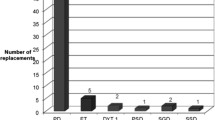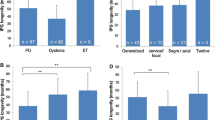Abstract
Technical dysfunctions have been reported reducing efficacy of deep brain stimulation (DBS). Here, we report on an essential-tremor patient in whom a short circuit in bipolar DBS resulted not only in unilateral loss of therapy but also in high current flow and thereby rapid decline of the impulse-generator battery voltage from 2.83 V a week before the event to 2.54 V, indicating the need for an impulse-generator replacement. Immediate re-programming restored therapeutic efficacy. Moreover, the reduction in current flow allowed the battery voltage to recover without immediate surgical intervention to 2.81 V a week later.

Similar content being viewed by others
References
Alesch F (2005) Sudden failure of dual channel pulse generators. Mov Disord 20:64–66
Allert N, Reyes Santana M, Karbe H (2016) Short circuit in deep brain stimulation for Parkinson’s disease mimicking stroke. Brain Stimul 9:950-951
Allert N, Markou M, Miskiewicz AA, Nolden L, Karbe H (2011) Electrode dysfunctions in patients with deep brain stimulation: a clinical retrospective study. Acta Neurochir (Wien) 153:2343–2349
Barbe MT, Pochmann J, Lewis CJ, Allert N, Wirths J, Visser-Vandewalle V, Timmermann L (2014) Utilization of predefined stimulation groups by essential tremor patients treated with VIM-DBS. Parkinsonism Relat Disord 20:1415–1418
Barbe MT, Liebhart L, Runge M, Pauls KA, Wojtecki L, Schnitzler A, Allert N, Fink GR, Sturm V, Maarouf M, Timmermann L (2011) Deep brain stimulation in the nucleus ventralis intermedius in patients with essential tremor: habituation of tremor suppression. J Neurol 258:434–439
Blomstedt P, Jabre M, Bejjani BP, Koskinen LO (2006) Electromagnetic environmental influences on implanted deep brain stimulators. Neuromodulation 9:262–269
Bronstein JM, Tagliati M, Alterman RL, Lozano AM, Volkmann J, Stefani A, Horak FB, Okun MS, Foote KD, Krack P, Pahwa R, Henderson JM, Hariz MI, Bakay RA, Rezai A, Marks WJ Jr, Moro E, Vitek JL, Weaver FM, Gross RE, DeLong MR (2011) Deep brain stimulation for Parkinson disease: an expert consensus and review of key issues. Arch Neurol 68:165
Fakhar K, Hastings E, Butson CR, Foote KD, Zeilman P, Okun MS (2013) Management of deep brain stimulator battery failure: battery estimators, charge density, and importance of clinical symptoms. PLoS One 8, e58665
Flora ED, Perera CL, Cameron AL, Maddern GJ (2010) Deep brain stimulation for essential tremor: a systematic review. Mov Disord 25:1550–1559
Guridi J, Rodriguez-Oroz MC, Alegre M, Obeso JA (2012) Hardware complications in deep brain stimulation: electrode impedance and loss of clinical benefit. Parkinsonism Relat Disord 18:765–769
Neuneier J, Barbe MT, Dohmen C, Maarouf M, Wirths J, Fink GR, Timmermann L (2013) Malignant deep brain stimulation-withdrawal syndrome in a patient with Parkinson’s disease. Mov Disord 28:1640–1641
Samura K, Miyagi Y, Okamoto T, Hayami T, Kishimoto J, Katano M, Kamikaseda K (2012) Short circuit in deep brain stimulation. J Neurosurg 117:955–961
Vidailhet M, Jutras MF, Grabli D, Roze E (2013) Deep brain stimulation for dystonia. J Neurol Neurosurg Psychiatry 84:1029–1042
Yang HJ, Yun JY, Kim YE, Lim YH, Kim HJ, Paek SH, Jeon BS (2015) Sudden loss of the deep brain stimulation effect with high impedance without macroscopic fracture: a case report and review of the published literature. Neuropsychiatr Dis Treat 11:1799–1803
Author information
Authors and Affiliations
Corresponding author
Ethics declarations
Conflict of interest
Niels Allert has received honoraria from Medtronic for lecturing and consulting. Michael T. Barbe has received speaker’s honoraria from Medtronic and GE. Lars Timmermann reports grants, personal fees and non-financial support from Medtronic, grants, personal fees and non-financial support from Boston Scientific, personal fees and non-financial support from SAPIENS, grants, personal fees and non-financial support from St. Jude Medical. Volker Arnd Coenen has received honoraria and travel support from Medtronic (USA, Europe), Boston Scientific (USA) and St. Jude Medical (USA). He has ongoing IITs with Medtronic and Boston Scientific with minimal financial support.
Informed consent
The patient has consented to submission of this case report to the journal.
Rights and permissions
About this article
Cite this article
Allert, N., Barbe, M.T., Timmermann, L. et al. Rapid battery depletion and loss of therapy due to a short circuit in bipolar DBS for essential tremor. Acta Neurochir 159, 795–798 (2017). https://doi.org/10.1007/s00701-017-3090-7
Received:
Accepted:
Published:
Issue Date:
DOI: https://doi.org/10.1007/s00701-017-3090-7




